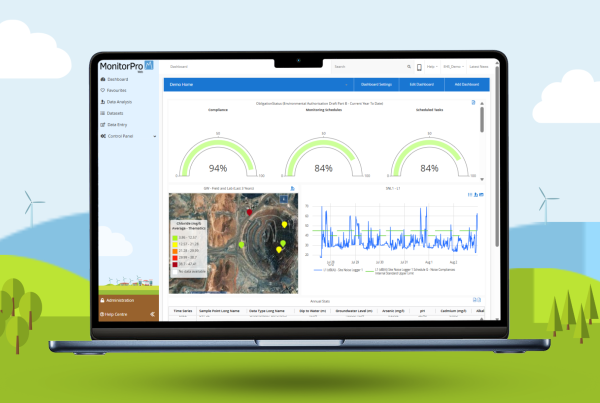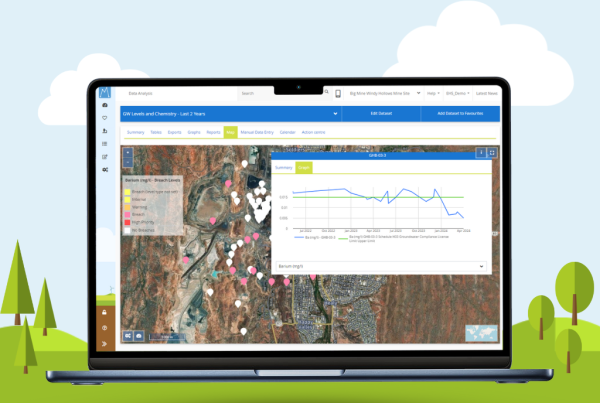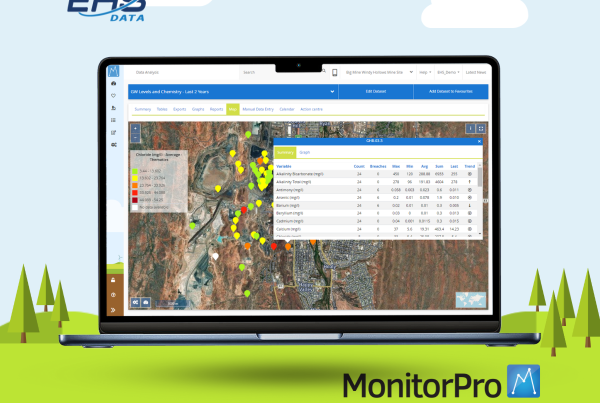EDMS Introduction
Most larger-scale operations that have the potential to pollute will have some form of regulation, wherever in the world they are located. Much of this regulation is associated with monitoring the immediate and local environment, to protect it from excessive pollution, while allowing operations to continue in a responsible way. To do this, data is collected and compared to compliance standards or historical norms to ensure compliance. This environmental monitoring over the medium to long term generates large amounts of data, ranging from groundwater, stream and treatment plant sampling data, loggers, field measurements, laboratory analytical results, and operational data just to name a few.
In order to effectively evaluate and maintain large amounts of information, professional Environmental Data Management Systems (EDMS) are invaluable in complying with these regulations. Using an EDMS to efficiently collect and store data can save time and money, reduce risks of prosecution and fines, assist with stakeholder engagement and ultimately help to protect the environment.
EDMS offerings sit in a specific group within a broader range of commercial off the shelf software (COTS), designed to assist companies to manage; broader corporate environmental risk, solving specific problems or functions such as modelling, or connecting to specific pieces of equipment. There is a dizzying array of acronyms for these such as Continuous Emissions Monitoring Systems (CEMS), Data Acquisition and Handling Systems (DAHS), and Environmental Information Management Systems (EIMS), as examples. It’s therefore important before you start, to understand your requirements, the broader landscape of solutions on offer, and how they offer to solve them.
If you’ve made it this far, we’ll assume you are in the right place and we’ll give you some more insight into an EDMS and what makes one right for you.
Once the decision has been made to adopt an EDMS, there is the (not insignificant) task of selecting the right one. The following sections will detail key areas to examine, followed by a section on a method of quantification, and finally, an example decision matrix to download and customise to suit your needs.
The EDMS Company
You will want to adopt an EDMS from a provider that is well established in its field, has a good reputation, and can support and develop the product for the expected life of your project. Some questions to ask and items to consider.
Reputation
- How long have they been established?
- What experience do they have working in your industry? (number of clients, number of countries, for how many years).
- Will they provide references or existing users to speak with?
- Do any national regulators use their systems?
- How big is their permanent development team and where are they based? Do they follow established development, build and test techniques and procedures? Are the developers sufficiently experienced and certified?
- Does their system have any quality certification for the development and provision specifically for an EDMS such as MCERTS?
- What is the background of the Implementation and Technical teams? Are they recruited from similar industries to yours? Do they have environmental monitoring and data management experience, and do they understand your business process intuitively, or are their backgrounds in Project Management or IT?
- Are they an ethical company in terms of employment (is development local or offshore) and consideration of the environment core in their policies? Do they have any Carbon or Environmental pledges?
- Are the staff involved in your project suitably vetted or security cleared? Does the company have robust induction processes for the right to work, past employment and criminal checks (for example BPSS)?
The EDMS Product
Once you have established the company has a robust proven track record and has staff that understand your business, it’s time to understand the product(s) they offer. Consideration should be given to the fact that if you are reaching out to software vendors in the market, you have decided to go with a COTS. That is, you may have to ‘do things differently to before’. Buying a system shouldn’t be a compromise if done correctly, it should have many benefits, however, it has to be accepted each application you review might solve the same problem in different ways. It’s important to understand which one fits best your current ways of working and where you are and aren’t prepared to compromise.
Features
- Know up front what features are most important to your business (mandatory) and which are discretionary or ‘nice to haves’.
- Are these features modular, how does it affect the pricing. Are the applications tailored to specific users?
Flexibility
- Will the application flex to your company’s requirements or will you have to compromise to work the way the application works?
- Can the application grow with your business needs, if you purchase a new site, your Permits are modified or simply testing for new compounds or at new locations?
- Does the company talk about customisation or configuration? Customisation requires new code to be written, it’s more invasive, generally costs more and comes with higher risks and ongoing maintenance. Configuration is the use of tools to meet specific requirements, it’s typically cheaper, can often be done by the users themselves and requires no specific long term support. If a company’s sales team are telling you anything is possible and the application can be customised to fit, be wary.
- Where customisation is offered ensure it is discreet, well-scoped and can be supported long term. These types of enhancements are typically acceptable when producing tailored reports, exports or import routines. Items that don’t fundamentally affect the core application or are designed by the vendor to be flexible.
Ease of use
- Is the layout intuitive, and what are the training requirements for each type of user?
- Is the system well documented with a knowledge base, manual or how-to videos?
- Does it have unique selling points such as saving datasets (per user) that can auto-update or favourites for quick access?
Platform
- Is there a browser-based application?
- Is there a desktop application?
- Is there an offline handheld field sampling app?
- Will it support the language(s) that you need is this user-configurable and do you need multilingual support?
- Scalability – what are some of the largest of their systems in use, in terms of numbers of locations monitored, parameters stored, and numbers of readings?
EDMS Functionality
All reasonable EDMSs will perform basic functions such as import a file and export, plus displaying graphs and reports, however environmental permits can contain complex requirements – and so you may need to consider some of the following features:
Workflow Management
- Can users enter their permit obligations and conditions in an asset register, and link these directly to monitoring requirements? Subsequently, are there KPI reports to show status against permit requirements, such as % of monitoring done, reports sent and compliance %?
- Planning, does it manage monitoring schedules and provide notifications for monitoring visits or missing samples or results from the lab?
- Does it have an action centre in the event of a breach to track remediation plans?
- Will it automatically inform recipients of compliance breaches?
Security and audits
- Can users be restricted to certain datasets? For example, your air monitoring team only being able to view air quality data.
- Can users be restricted to certain functionality?
- Can datasets be locked to prevent unauthorised reporting?
- Are there ‘read only’ roles?
- Is there an audit trail for all edits?
- Is there an audit trail of the actions of users as they use the system and manage stale user accounts?
Input and validation
- How sophisticated is the importer, does it have the ability to scan a file and read columns and rows without user intervention? Does it require you to provide data in a specific Electronic Data Deliverable (EDD) or is it more flexible?
- For complex or non-standard files can import routines be built to ensure seamless imports without users editing files for import?
- Can associated data be embedded and referenced such as photos and laboratory certificates?
- How sophisticated are its aliasing and resolution system? Can it over time be taught varying names for objects, so that it can automatically resolve variations in spelling for future imports?
- How capable is the compliance management system? Some compliance or warning levels are not simply fixed levels but rely on trends, calculations or interaction with other datasets (such as up-gradient locations).
- Will it support varying locales for dates and decimal separators, or only one?
- Can it automatically extract data from data sources on a schedule such as historians like Pi, ERPs such as SAP, and other databases or loggers?
- Can it automatically import files from network folders?
- Will it monitor email inboxes for seamless importing and process files based on configured rules?
- How sophisticated is the calculator, can users set up their own calculations with functions such as interpolation, IF statements, percentiles, aggregation, factors, and constants?
Spatial Analysis
- Does it provide up to date and high-resolution satellite imagery and spectrum analysis (water, vegetation etc.)?
- Does it have contour plots functions?
- Can you include areas of interest, such as boundaries and associate data with them?
Outputs
- Is output static or flexible to provide the required regulatory reports and output types?
- Will it integrate with other onward systems such as BI Tools?
- Does it allow for secure database connections to onward systems and offer a functional API?
EDMS Licensing, hosting and support
Licencing models vary from vendor to vendor and so it’s important in any comparison to compare like with like. Understanding your business’s attitudes to self-hosting applications vs outsourcing is also an important consideration. You should find out from your IT department early in the process if there is a mandated preference, as it can significantly reduce the time and complexity of the sales process. If your company will only allow your data to be stored on-premise but you like the functionality of a SaaS only solution, then you’ll be wasting your time including them in your assessment.
License model
- Is Software as a Service (SaaS) offered and is this the only offering?
- Is perpetual licensing offered?
- Is the pricing model named user or concurrent?
- Are there pack pricing or volume discounts applicable and are you made aware of what they are?
- What are the legal and contractual requirements stipulated by the vendor?
Hosting
- Are hosting services offered?
- In which country are the servers located and are you given an option?
- Is there an option for a dedicated or shared server (a balance of performance versus cost)?
- Is the data secure, is the server’s security backed, accredited and audited? Will the provider share this information?
- Is the hosting offering SaaS only (leased licences) or can you purchase licences but still have the vendor host (PaaS)?
- Are all associated server licencing costs included in the pricing?
- Will the vendor allow the installation of other software on the server for integration?
- Does the vendor offer a Hosting Service Level Agreement stipulating uptime and response time to outages?
Ongoing support
- Where is support based, and what is the skill level of the personnel responding?
- Are tickets and issues raised tracked in a dedicated ticketing system?
- Are software updates included in the maintenance plan?
- Are the levels of support that you need, offered, for example, regular account manager meetings, regular training sessions included, advice or limited cover for bugs only?
- Do they have representation in the language you require?
- Do they have a Service Level Agreement (SLA) that states service levels and expectations?
EDMS Cost, Implementation and Termination
Cost
It is important to find a system within your budget. For this, there are a few things to consider – not only the cost of the software license. Consider the system cost as a whole, over three years or more, and include licensing, likely implementation and ongoing maintenance costs, as well as a budget for ongoing training if needed. It’s important to factor in internal costs also and where these are budgeted. Where in your organisation are the IT costs incurred? Self-hosting on paper will always be the most cost-effective solution if the internal costs of self-hosting are themselves not considered!
- Is the pricing open and clear to understand?
- Price breaks and pack pricing options available?
- Are you comparing like with like between vendors?
- Have you factored in fair comparisons for internal costs when comparing with vendor-hosted solutions?
- Currency considerations?
Implementation
- What experience does the implementation team have with your type of system? Why not ask for a summary of their experience?
- Does the implementation follow a well-established process with good project management and quality control processes?
- Do the staff have formal Project Management certification/membership?
- Is a pre-implementation scoping exercise offered?
- How long will implementation take, and how long is any waiting list?
- What are the implementation travel and expense rates?
- Will periodic reviews be scheduled during the build process?
- Will access be given to the system for approval prior to on-site training?
Termination
If it doesn’t work out, what is the situation regarding termination? You might be required to manually export your data as .csv files. This might be time-consuming and not give you all of your information back.
How to Choose an EDMS
One way to help with the decision-making process is a decision matrix, or Pugh method.
List your options as rows on a table, and the factors you need to consider as columns. You then score each option/factor combination, weight this score by the relative importance of the factor, and add these scores up to give an overall score for each option.
While this sounds complex, this technique is actually quite easy to use. Here’s a step-by-step guide
List all of your options as the row labels on the table, and list the factors that you need to consider as the column headings.
Next, work your way down the columns of your table, scoring each option for each of the factors in your decision. Score each option from 0 (poor) to 5 (very good). Note that you do not have to have a different score for each option
For all of the areas that are have importance for current or future situations assign numbers from, say, 0 to 5, where 0 means that the factor is absolutely unimportant in the final decision, and 5 means that it is very important.
Now multiply each of your scores from step 2 by the values for the relative importance of the factor that you calculated in step 3. This will give you weighted scores for each option/factor combination.
Finally, add up these weighted scores for each of your options. The option that scores the highest wins.
If your intuition tells you that the top-scoring option isn’t the best one, then reflect on the scores and weightings that you’ve applied. This may be a sign that certain factors are more important to you than you initially thought.
Also, if an option scores very poorly for a factor, decide whether this rules it out altogether.
About MonitorPro
The complete, professional environmental data monitoring solution, MonitorPro is the IT solution trusted by environmental teams worldwide to manage their environmental compliance and data collection. MonitorPro is a web-based or locally hosted solution for the collation of ALL sources of environmental data, where it is generated by loggers, laboratories, weather stations, calculations, or other data repositories. MonitorPro is the first EHS Software solution to receive an MCERTS accreditation from the Environmental Agency.
About EHS Data
EHS Data is a world leading UK based software company providing Environmental Data Management Solutions to over 1,000 sites in 40 countries worldwide. For over 20 years, our versatile software solution, MonitorPro, has helped organisations save time, improve planning, quality control, site analysis and reporting to manage environmental obligations and sustainability.
ISO 27001
EHS Data is ISO 27001 certified.
A Carbon Negative Business
In 2020, EHS Data attained Carbon negative status and is committed to maintaining this status each year.




